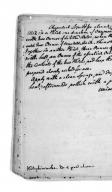[ Chymical Liquid for Cleaning Boot Tops ] William Paine
Date: Recorded 1814 or later, after the publication of the source. | 1814/01/01 to 1814/12/31
Source:
William Paine Papers
Institution: University Of New Brunswick
| Source Origin: Loyalist Collection
| Reference: MIC-Loyalist FC LFR.P3W5P3
Instructions for preparing boot polish. The version here likely comes from The Universal Receipt Book (p. 314 of the second edition [Philadelphia: Isaac Riley, 1818]). The recipe also appears in several other 19th-century publications, including The Young Man's Best Companion, The Family Receipt Book, and One Thousand Experiments in Chemistry. Reel 3, p. 656. Image use courtesy of the American Antiquarian Society.
Chymical Liquid for Cleaning BootTops
Mix in a Phial one drachm of Oxymuriate of Potash
with two Ounces of distilled Water, when the Salt is dissolved
add two Ounces of Muriatic Acid. Then shaking Well
Together in another Phial, three Ounces of rectified Wine
with half an Ounce of the essential Oil of Lemon, unite
the Contents of the two Phials, and keep the liquid thus
prepared closely corked for use.
Apply with a clean Sponge, and dry in a gentle
heat, afterwards pollish with a proper Brush.
Universal RBook.
Kutchimmoke. Be of good cheer.
Download: Transcription | Images
